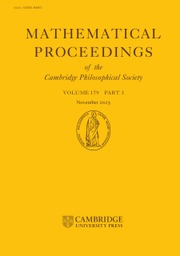The application of quadratic forms in an infinity of variables to boundary problems in partial differential equations
Published online by Cambridge University Press: 24 October 2008
Extract
The object of this paper is to find the characteristic functions and the characteristic numbers of the partial differential equation

valid in a domain G, and where  on Γ, the boundary of G. The method employed is to transform two quadratic forms to their common self-conjugate “triangle“ of reference. The solution to the problem is given by this method in a simple manner, without the use of the integral equation theory, or the use of minimal sequences.
on Γ, the boundary of G. The method employed is to transform two quadratic forms to their common self-conjugate “triangle“ of reference. The solution to the problem is given by this method in a simple manner, without the use of the integral equation theory, or the use of minimal sequences.
Information
- Type
- Research Article
- Information
- Mathematical Proceedings of the Cambridge Philosophical Society , Volume 28 , Issue 1 , January 1932 , pp. 23 - 34
- Copyright
- Copyright © Cambridge Philosophical Society 1932
References
* Courant-Hilbert, , Methoden der mathematischen Physik, Ch. 6.Google Scholar
† The method of this paragraph is obtained from Hilbert, , Grundzüge einer allgemeine Theorie der linearen Integralgleichungen, pp. 147et seq.Google Scholar
* When ![]() , hence |x i| < √K.
, hence |x i| < √K.
* By this we mean that every point of C 1′ is at an equal distance δ from C 1, and that C 1′ has no double points.
* Courant-Hilbert, loc. cit., Ch. 6, p. 328.
- 1
- Cited by

